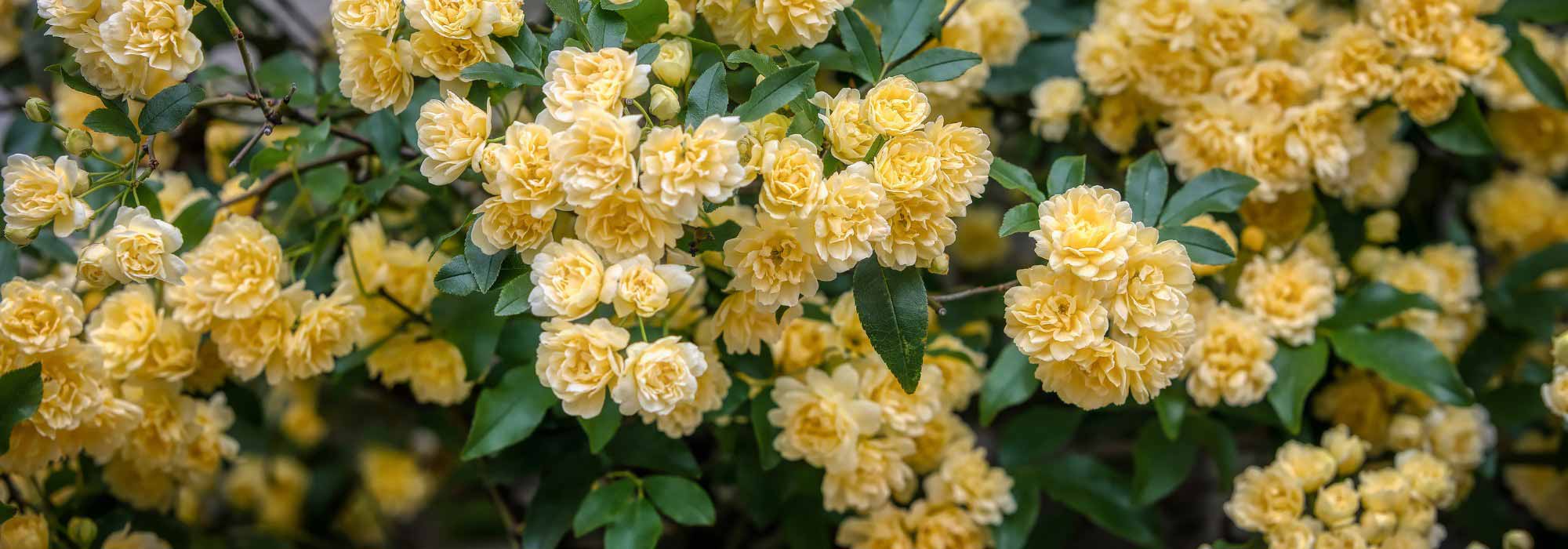
Banks' Roses: Discover These Exuberant Liana Roses!
Varieties, planting and care advice
Contents
Banksian roses are extremely vigorous climbing roses, offering beautiful yellow, pink or white flowers. These liana roses are very easy to grow, they are thorn-free and flower abundantly in spring. Their flowering is a true spectacle! With rapid growth, they are perfect for covering walls, pergolas and trellises with a profusion of flowers.
Discover everything you need to know about these incredible spring-flowering roses: their assets, the most attractive varieties, how to grow them and which plants to pair them with in the garden to create successful combinations!
What is a Banks' rose?
Banks’ Rose, or Rosa banksiae, is a liana rose native to China that captivates with its spectacular flowering. It owes its name to Dorothea Banks, wife of the botanist Joseph Banks. This is a climbing rose with very rapid growth and semi-evergreen foliage. It easily clings to the supports provided, whether walls, pergolas, or even old trees. Come spring, typically between April and June, it becomes covered in countless clusters of flowers, light and fragrant, which illuminate the garden with a romantic and rustic touch. Depending on the variety, its flowers can be yellow, pink, or white, and single (wild rose-like), double, or semi-double (depending on the number of petal ranks that compose them).
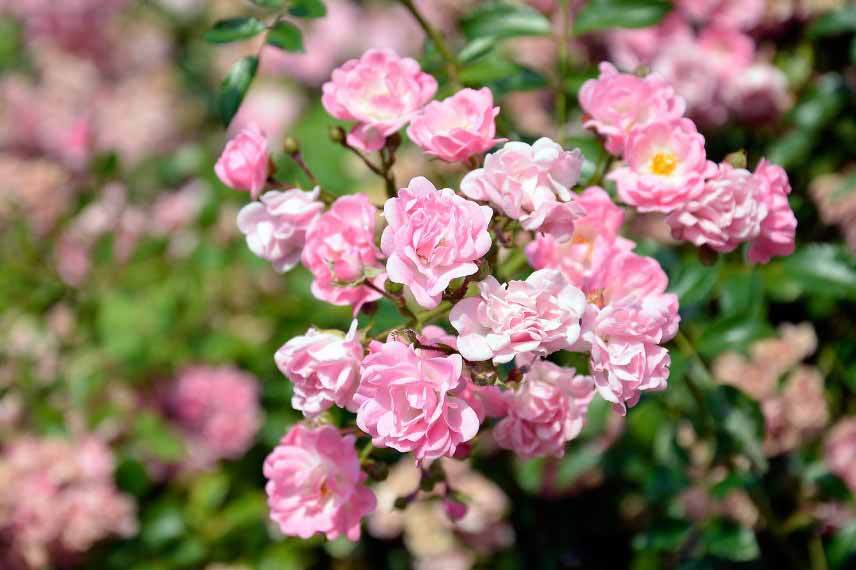
Rosa banksiae ‘Rosea’
Read also
10 climbing roses for pergolaWhy choose a Banks' rose?
The Banks’ rose has many advantages:
- It’s a very vigorous climbing rose, which grows quickly and can reach up to ten metres in height. It’s perfect for covering a pergola, façade or arbour in no time!
- It has no thorns, making it easier to grow and handle.
- In spring, it offers an exceptionally abundant flowering, literally covering itself in flowers.
- There are different varieties, with single or double flowers, in yellow, white or pink.
- It’s disease-resistant, making it an ideal alternative to classic roses, which are often more delicate.
- It requires very little maintenance and is easy to grow.
- It has semi-evergreen to evergreen foliage: in mild climates, it keeps its leaves all year round.
Banks' Rose: Is it perpetual?
Unlike some roses that have the ability to flower several times a year (for example ‘Pierre de Ronsard’, to stay within climbing roses), the Banks’ rose flowers only once, between April and June, but its flowering is then spectacular! We easily forgive its single flowering, as it becomes covered with a multitude of flowers in clusters, offering a true spectacle.
There is, however, one variety of Banks’ rose that is an exception: the ‘Purezza’ rose is indeed perpetual! It flowers first in spring, then more sporadically during summer, sometimes until October depending on the climate. It benefits from this particularity as it is a hybrid between a Banks’ rose (Rosa banksiae ‘Lutescens’) and the ‘Tom Thumb’ rose, which passed on its perpetual character.
Read also
How to choose a rambling rose?The best varieties of Banks' rose
There are several varieties of Banks’ roses, which mainly differ in their colour:
- Rosa banksiae ‘Lutea’ : this is the most commonly cultivated Banks’ rose. It produces double yellow flowers with a light fragrance.
- Rosa banksiae ‘Alba Plena’ : in May, it bears double white flowers with a romantic appearance, their scent reminiscent of violets.
- Rosa banksiae ‘Alba’ : with its single white flowers and golden centres, this Banks’ rose has a more natural and rustic style. It is also known as Rosa banksiae var. Normalis.
- Rosa banksiae ‘Rosea’ : prized for its double pink flowers, gathered in dense clusters. They are particularly delicate and romantic.
- Rosa banksiae ‘Purezza’: this is a hybrid that is hardier and less vigorous than other Banks’ roses. It is also perpetual, flowering first from March to May, then sporadically throughout summer or autumn. It produces beautiful semi-double white flowers.
- Rosa banksiae ‘Lutescens’ : rarer in cultivation, it produces countless small, fragrant yellow wild roses.
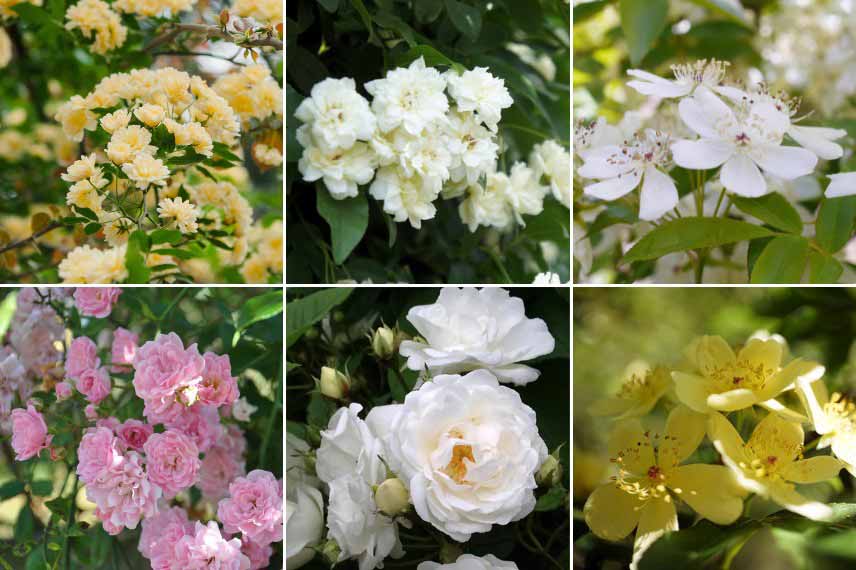
The varieties Rosa banksiae ‘Lutea’, ‘Alba Plena’ (photo: T. Kiya), ‘Alba’, ‘Rosea’ ‘Purezza’ and ‘Lutescens’
How to incorporate Banks' roses in the garden and which plants to pair them with?
Thanks to its rapid growth and dense foliage, the Banks’ rose can be used to adorn various structures in the garden. It is ideal for covering a wall or fence, adding a romantic and natural touch. It can also be trained over a pergola or arbour, creating a shaded space in bloom during spring. Another interesting option is to let it climb a tree: its flexible stems intertwine with the branches without harming the health of the host tree.
It is interesting to pair the Banks’ rose with other climbing plants that will take over once its flowering period ends. Consider, for example, a summer-flowering clematis, a fragrant honeysuckle, or a star jasmine (Trachelospermum jasminoides). Wisterias and trumpet vines also make good companions, but ensure they have a sturdy enough support.
It also depends on the flower colour of the Banks’ rose you are growing: for Rosa banksiae ‘Lutea’, pair its bright blooms with other yellow, orange, or red flowers… Think, for instance, of the trumpet vine Campsis capreolata, the Erysimum ‘Winter Light’, the Iris germanica ‘Burst’, the avens ‘Feuermeer’, and the rockrose ‘Hartswood Ruby’. You could also opt for violet-mauve flowers to play with complementary colours! Conversely, if you grow a pink or white-flowered Banks’ rose (Rosa banksiae ‘Rosea’, ‘Alba Plena’, ‘Purezza’…), create a romantic atmosphere by pairing it with the clematis ‘White Pearl’ or ‘Picotee’, the lilac Syringa microphylla ‘Superba’, peonies, hardy geraniums, Iris germanica ‘Glacier’, pinks such as Dianthus ‘Scent First Romance’ or Dianthus deltoides ‘Rosea’… Also include perennials with decorative foliage like the artemisia Artemisia stelleriana ‘Boughton Silver’ and the Stachys byzantina.
To pair with the Banks’ rose, explore all our clematis varieties: they are perfect companions!
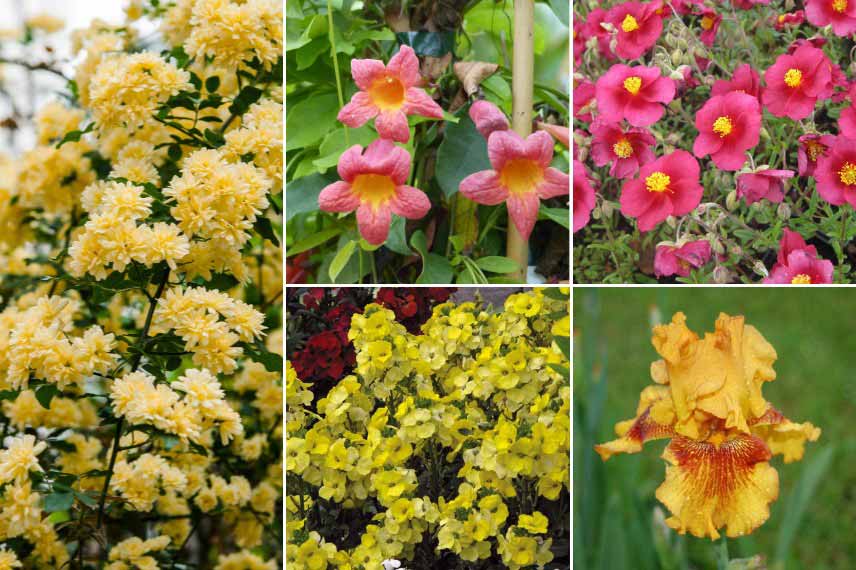
Rosa banksiae ‘Lutea’, Campsis capreolata, Helianthemum ‘Hartswood Ruby’, Erysimum ‘Winter Light’ and Iris germanica ‘Burst’
The Banks’ rose can also be planted at the base of a sturdy tree, such as an old apple tree or oak, whose trunk it will naturally climb, adorning the branches with cascades of flowers. In a border, it will pair well with bushy plants with a flexible habit like ceanothus or lilac, offering an interesting contrast in textures and colours.
If you wish to create a Mediterranean ambiance, pair it with olive trees, lavenders, rockroses, or rosemary, which will enhance its natural, sun-kissed appeal while requiring minimal maintenance.
How to care for a Banks' rose?
One of the great advantages of the Banks’ rose is its low maintenance. Once well established, it requires little intervention. Watering is only necessary in the first year, and then only during prolonged dry spells. A dose of compost or organic fertiliser in early spring will encourage beautiful flowering.
Pruning is not essential but can be carried out after flowering if the rose becomes too invasive. Simply shorten the stems slightly to control its growth. Unlike other roses, it does not require severe pruning, which simplifies its care.
In winter, in colder regions, it is advisable to protect the base with a thick mulch and winter fleece, especially during the first few years when the young plants are still establishing. Once mature, the Banks’ rose is robust enough to withstand temperatures as low as -10°C without special protection.
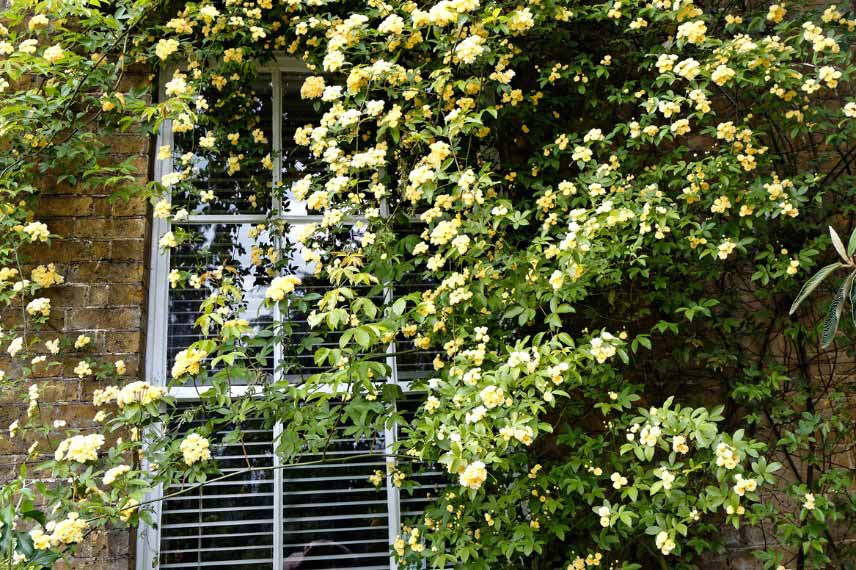
Highly vigorous, the Banks’ rose may require pruning to limit its spread
- Subscribe!
- Contents
































Comments